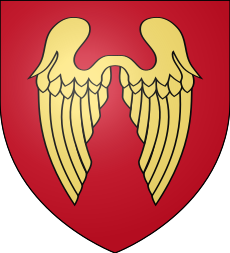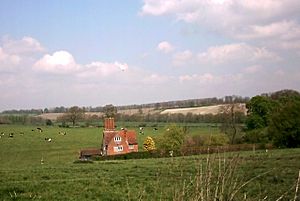Wulfhall facts for kids
Quick facts for kids Wulfhall Farmhouse |
|
|---|---|
 |
|
| Location | Burbage, Wiltshire |
| OS grid reference | SU 24162 62107 |
| Architectural style(s) | Victorian architecture |
| Owner | Binney family |
|
Listed Building – Grade II
|
|
| Designated | 27 February 1998 |
| Reference no. | 1031619 |
| Lua error in Module:Location_map at line 420: attempt to index field 'wikibase' (a nil value). | |
Wulfhall or Wolfhall is a historic country house in Burbage, England. It was built in the early 1600s. The house is located north-east of Burbage village. It is about 5 miles (8 km) south-east of Marlborough.
A much older house once stood on the same spot. This earlier house was the main home of the Seymour family. A famous member of this family was Jane Seymour. She became queen to King Henry VIII of England.
Contents
The Old Manor House: A Royal Connection
The original Wulfhall manor house was likely built with wood frames. It had two courtyards and two towers. It also featured a long gallery and a chapel. Many other rooms were part of this large home.
This grand house was built in the early 1530s. Thomas Cromwell and King Henry VIII helped pay for it. The Seymour family became very powerful in the 1500s. This was especially true when Jane Seymour married King Henry VIII. She became his third wife.
Jane Seymour and King Edward VI
Jane Seymour's son became Edward VI. He ruled England from 1547 to 1553. Edward was only nine years old when he became king. His oldest uncle, Edward Seymour, 1st Duke of Somerset, became the Lord High Protector of England. This meant he ruled the country for the young king.
Another uncle, Thomas Seymour, 1st Baron Seymour of Sudeley, married Catherine Parr. She was King Henry VIII's widow. Both Edward and Thomas Seymour were later put to death. They were accused of going against the king.
King Henry VIII's Visit to Wulfhall
King Henry VIII visited Wulfhall in 1535. It is thought that he first met Jane Seymour here. At this time, Henry's second wife, Anne Boleyn, had not had a son. This may have led to her later execution.
Some people believed that Henry and Jane had their wedding feast at Wulfhall. This idea came from a writer in the 1800s. However, they actually got married in London. Their wedding took place at Whitehall Palace.
The Decline of the Old Wulfhall
Edward Seymour wanted a grander home. He planned to build a new mansion nearby. His steward, Sir John Thynne, helped with the design. Sir John Thynne also founded Longleat House.
Letters from 1548 to 1549 show Thynne's plans. The new mansion was not finished. Edward Seymour lost his power and was executed in 1552. His son could not keep up Wulfhall. The house quickly fell apart.
The old Wulfhall was left empty after 1571. The Seymour family had moved to Tottenham Park. The old house was used for servants for a while. It was made much smaller in the 1660s. Finally, it was torn down in 1723.
A few ruins remained until the early 1900s. Nothing is left above ground today. Its foundations were found in 2017 and 2018. The barn where Henry and Jane supposedly had their feast burned down in the 1920s.
The Present Wulfhall Manor House
The Wulfhall manor house you see today is from the early 1600s. It started as a simple farmhouse. It was made larger in the 1700s. It also has a Victorian style front.
Current Owners and Local Stories
The Binney family owns the current manor house. They inherited it in 2013. Seven people live in the main house. It has been divided into parts for tenants.
In 2015, Dominic Binney spoke about the house. He said, "Many people have felt a presence here. It makes their hair stand on end. This feeling is not just from an old house's creaky sounds. I have felt and heard things that cannot be explained."
A nearby house is called Wolfhall Farm. It is on a small road leading from Burbage. This farmhouse is about 200 yards from where the old Wulfhall stood. It was built in the late 1500s.
Wulfhall in Books
Wulfhall inspired the title of Wolf Hall. This book won the Man Booker Prize. It was written by English author Hilary Mantel. Its sequel, Bring Up the Bodies, also won the Man Booker Prize. This second book starts with the King arriving at Wolf Hall in 1535.



